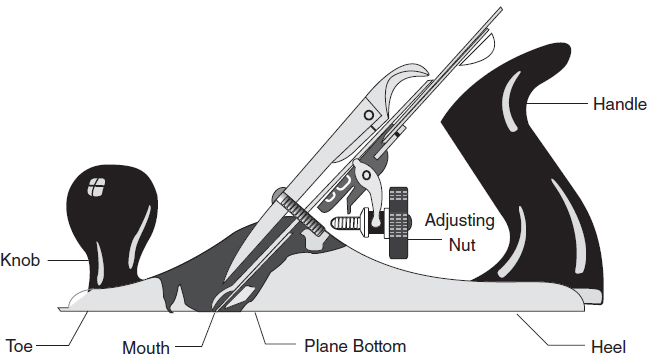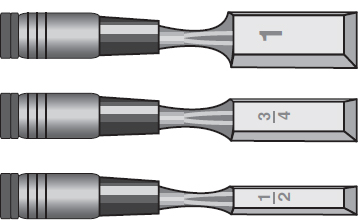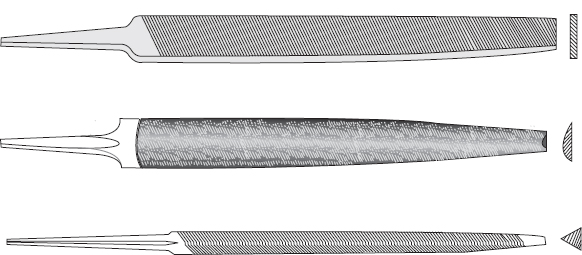Finishing Tools
Planes
When working with wood, there are many occasions when it is necessary to shave off a small amount of material to make a piece fit properly or to make a surface smooth. One tool that can be used for this purpose is a plane.
There are several different types of planes, but the one that would be best-suited for general purpose work is the jack plane. The jack plane has a smooth lower surface (plane bottom) and an adjustable-depth blade that protrudes slightly below this surface (through the mouth). This blade is set at an angle, similar to the blade in a disposable razor.

When using a jack plane, the carpenter grasps the plane with both hands and moves it evenly across the surface of the work, “shaving” a thin layer of wood. If a heavier cut is desired, the blade can be adjusted to protrude farther from the lower surface of the plane.
Wood Chisels
Wood chisels may also be used to shape or smooth a wood surface. Wood chisels come in a variety of widths, which can range from
 " to 2". A wood chisel is normally hand-operated, but when making deep cuts, a soft-faced mallet should be used to lightly tap the chisel through the work.
" to 2". A wood chisel is normally hand-operated, but when making deep cuts, a soft-faced mallet should be used to lightly tap the chisel through the work.

Files and Rasps
Files are used to smooth, polish, and shape materials. Files are made from hardened steel and consist of diagonal rows of teeth. These teeth can be arranged as either a single row of parallel teeth (single-cut) or one row of teeth crisscrossing with another row (double-cut). Files are made in flat, round, half-round, and triangular designs.
Most files do not come with handles. It is important to have a handle ready to attach to a file when it is put to use, as this will prevent the end of the file from being driven into the technician’s hand. Remember that a file is made to cut only on the forward stroke, so it should be lifted slightly from the work when it is pulled back.

Rasps are basically very coarse files that are used to trim, shape, and smooth materials. While files are used for fine finishes, rasps are used for coarse work. Round rasps are useful for cleaning up holes, whereas a flat rasp would be used to smooth flat surfaces. The cutting teeth on a rasp are coarse enough to clear sawdust easily, so the rasp is always ready for the next stroke.

The ASVAB may ask you which tools can be used together on a project. Here is an example:
| Question | Analysis |
|
Which of the following finishing tools may be used with a mallet?
|
Step 1: This question asks which tool would be most appropriate to use with a mallet. Step 2: There is nothing to simplify. Step 3: Predict the tool that would most likely be struck by a mallet during normal operation. Step 4: Only choice (B) is commonly struck by a mallet, to make deep cuts. |
Try this example on your own.
-
What must be used in conjunction with a file for safe operation? - mallet
- file
- chisel
- handle
Explanation
The correct answer here is (D) handle. Many files are sold without handles attached, but it is important to use a handle whenever you use a file, to prevent the pointed end of the file from injuring the palm of your hand.